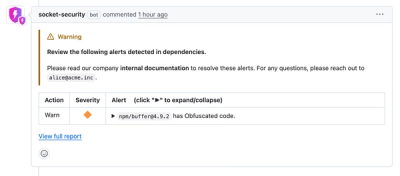
Security News
Crates.io Users Targeted by Phishing Emails
The Rust Security Response WG is warning of phishing emails from rustfoundation.dev targeting crates.io users.
@changey/react-leaflet-markercluster
Advanced tools
React wrapper of Leaflet.markercluster for react-laeflet
React wrapper of Leaflet.markercluster for react-leaflet

Examples with the Documentation: https://yuzhva.github.io/react-leaflet-markercluster/
CodeSandbox Getting Started
If you are faced with an issue with markers overlapping during map zooming, or they are
overlapping because they are close to each other - you probably need to group them.
That is what you can do with react-leaflet-markercluster.
Just grab your markers inside <MarkerClusterGroup /> component, right after <TileLayer />:
import MarkerClusterGroup from 'react-leaflet-markercluster';
<MarkerClusterGroup>
<Marker position={[49.8397, 24.0297]} />
<Marker position={[52.2297, 21.0122]} />
<Marker position={[51.5074, -0.0901]} />
</MarkerClusterGroup>;
Note: Before getting started, please see these useful guides:
1. Install package:
yarn add react-leaflet-markercluster@next # yarn
npm install react-leaflet-markercluster # npm
NOTE: the @next is required for react-leaflet v3 support. If you are still using react-leaflet v3, add dependency as react-leaflet-markercluster@^2.x.x
The react-leaflet-markercluster requires leaflet.markercluster as peerDependency
(Leaflet and react-leaflet also should be installed)
yarn add leaflet.markercluster leaflet react-leaflet # yarn
npm install leaflet.markercluster leaflet react-leaflet # npm
2. Import markercluster and leaflet styles:
@import '~leaflet/dist/leaflet.css'; // sass
@import '~react-leaflet-markercluster/dist/styles.min.css'; // sass
require('~leaflet/dist/leaflet.css'); // inside .js file
require('react-leaflet-markercluster/dist/styles.min.css'); // inside .js file
Or include CSS styles directly to the head of HTML file:
<link rel="stylesheet" href="https://unpkg.com/leaflet/dist/leaflet.css" />
<link
rel="stylesheet"
href="https://unpkg.com/react-leaflet-markercluster/dist/styles.min.css"
/>
3. Write some simple react-leaflet Map:
import { MapContainer, TileLayer, Marker } from 'react-leaflet';
<MapContainer
className="markercluster-map"
center={[51.0, 19.0]}
zoom={4}
maxZoom={18}
>
<TileLayer
url="https://{s}.tile.openstreetmap.org/{z}/{x}/{y}.png"
attribution='© <a href="http://osm.org/copyright">OpenStreetMap</a> contributors'
/>
<Marker position={[49.8397, 24.0297]} />
<Marker position={[52.2297, 21.0122]} />
<Marker position={[51.5074, -0.0901]} />
</MapContainer>;
NOTE: Remember to add map styles .markercluster-map { height: 90vh; }.
4. Just grab your markers inside <MarkerClusterGroup /> component, right after <TileLayer />:
import MarkerClusterGroup from 'react-leaflet-markercluster';
<MarkerClusterGroup>
<Marker position={[49.8397, 24.0297]} />
<Marker position={[52.2297, 21.0122]} />
<Marker position={[51.5074, -0.0901]} />
</MarkerClusterGroup>;
More examples with the Documentation
CodeSandbox Getting Started
Just pass whatever option you need from All Leaflet.markercluster Options to MarkerClusterGroup as prop.
For example:
<MarkerClusterGroup showCoverageOnHover={false} />
or:
const createClusterCustomIcon = function (cluster) {
return L.divIcon({
html: `<span>${cluster.getChildCount()}</span>`,
className: 'marker-cluster-custom',
iconSize: L.point(40, 40, true),
});
}
<MarkerClusterGroup iconCreateFunction={createClusterCustomIcon} />
P.S: Examples for v1 are available at CHANGELOG.md
You are able to add any listener, supported by Leaflet, with simple on property prefix.
1. Clone the repo:
git clone https://github.com/YUzhva/react-leaflet-markercluster.git
2. Install all dependencies:
yarn install --no-lockfile # yarn
npm install # npm
3. Start the server:
yarn dev # yarn
npm run dev # npm
4. After starting the server, storybook should automatically open the following address:
http://localhost:8080/
Thanks goes to these wonderful people:
Avatars rendered by contributors-img.
Special thanks to:
All sources are placed in the ./src folder:
1. Fork the repo.
2. Edit react-leaflet-markercluster.js plugin or style.scss style files.
3. Commit your changes and open Pull Request.
:beer: Thank you for contribution :beer:
UMD builds are available on unpkg:
<!-- unpkg, production code (minified) -->
<script src="https://unpkg.com/react-leaflet-markercluster/dist/index.js"></script>
<!-- unpkg, development code -->
<script src="https://unpkg.com/react-leaflet-markercluster/src/react-leaflet-markercluster.js"></script>
<!-- unpkg, production styles (minified) -->
<link
rel="stylesheet"
type="text/css"
href="https://unpkg.com/react-leaflet-markercluster/dist/styles.min.css"
/>
<!-- unpkg, development styles -->
<link
rel="stylesheet"
type="text/css"
href="https://unpkg.com/react-leaflet-markercluster/src/styles.scss"
/>
MIT License, see LICENSE file.
FAQs
React wrapper of Leaflet.markercluster for react-laeflet
We found that @changey/react-leaflet-markercluster demonstrated a not healthy version release cadence and project activity because the last version was released a year ago. It has 1 open source maintainer collaborating on the project.
Did you know?

Socket for GitHub automatically highlights issues in each pull request and monitors the health of all your open source dependencies. Discover the contents of your packages and block harmful activity before you install or update your dependencies.

Security News
The Rust Security Response WG is warning of phishing emails from rustfoundation.dev targeting crates.io users.

Product
Socket now lets you customize pull request alert headers, helping security teams share clear guidance right in PRs to speed reviews and reduce back-and-forth.

Product
Socket's Rust support is moving to Beta: all users can scan Cargo projects and generate SBOMs, including Cargo.toml-only crates, with Rust-aware supply chain checks.